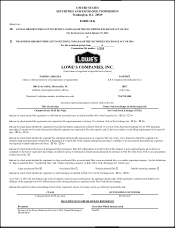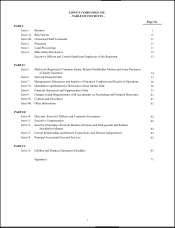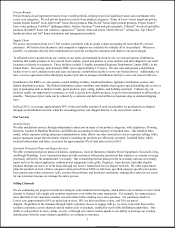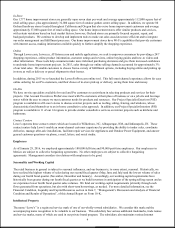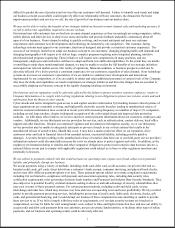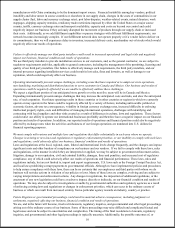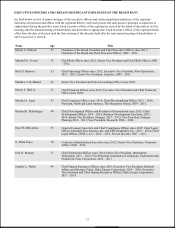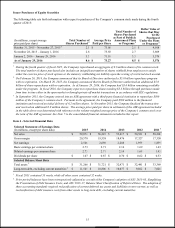Lowe's 2015 Annual Report Download - page 17
Download and view the complete annual report
Please find page 17 of the 2015 Lowe's annual report below. You can navigate through the pages in the report by either clicking on the pages listed below, or by using the keyword search tool below to find specific information within the annual report.
8
As customer-facing technology systems become an increasingly important part of our omni-channel sales and marketing
strategy, the failure of those systems to perform effectively and reliably could keep us from delivering positive customer
experiences.
Access to the internet from computers, tablets, smart phones and other mobile communication devices has empowered our
customers and changed the way they shop and how we interact with them. Our websites, including Lowes.com and
Lowesforpros.com, is a sales channel for our products, and is also a method of making product, project and other relevant
information available to them that impacts our in-store sales. Additionally, we have multiple affiliated websites and mobile
apps through which we seek to inspire, inform, cross-sell, establish online communities among and otherwise interact with our
customers. Performance issues with these customer-facing technology systems, including temporary outages caused by
distributed denial of service or other cyber-attacks, or a complete failure of one or more of them without a disaster recovery
plan that can be quickly implemented could quickly destroy the positive benefits they provide to our home improvement
business and negatively affect our customers’ perceptions of Lowe’s as a reliable online vendor and source of information about
home improvement products and services.
If we fail to hire, train, manage and retain qualified sales associates and specialists with expanded skill sets or corporate
support staff with the capabilities of delivering on strategic objectives, we could lose sales to our competitors, and our labor
costs, resulting from operations or the execution of corporate strategies, could be negatively affected.
Our customers, whether they are homeowners, renters or commercial businesses, expect our sales associates and specialists to
be well trained and knowledgeable about the products we sell and the home improvement services we provide. We compete
with other retailers for many of our sales associates and specialists, and we invest significantly in them with respect to training
and development to strive for high engagement. Increasingly, our sales associates and specialists must have expanded skill
sets, including, in some instances, the ability to do in-home or telephone sales. A critical challenge we face is attracting and
retaining a sufficiently diverse workforce that can deliver relevant, culturally competent and differentiated experience for a
wide variety of culturally diverse customers. In fact, many of our stores our employees must be able to serve customers whose
primary language and cultural traditions are different from their own. Additionally, in order to deliver on the omni-channel
expectations of customers, we rely on the specialized training and capabilities of corporate support staff which are broadly
sought after by our competitors. If we are unable to hire, train, manage and retain qualified sales associates and specialists, the
quality of service we provide to our customers may decrease and our results of operations could be negatively affected.
Furthermore, our ability to meet our labor needs while controlling our costs is subject to a variety of external factors, including
wage rates, the availability of and competition for talent, health care and other benefit costs, our brand image and reputation,
changing demographics, and adoption of new or revised employment and labor laws and regulations. Periodically, we are
subject to labor organizing efforts, and if we become subject to collective bargaining agreements in the future, it could
adversely affect how we operate our business and adversely affect our labor costs and our ability to retain a qualified
workforce.
Positively and effectively managing our public image and reputation is critical to our business success, and, if our public
image and reputation are damaged, it could negatively impact our relationships with our customers, vendors and store
associates and specialists and, consequently, our business and results of operations.
Our public image and reputation are critical to ensuring that our customers shop at Lowe’s, our vendors want to do business
with Lowe’s and our sales associates and specialists want to work for Lowe’s. We must continue to manage, preserve and grow
Lowe’s public image and reputation. Any negative incident can erode trust and confidence quickly, and adverse publicity
about us could damage our reputation and brand image, undermine our customers’ confidence, reduce demand for our products
and services, affect our relationships with current and future vendors, impact our results of operations and affect our ability to
retain and recruit store associates and specialists. The significant expansion in the use of social media over recent years has
compounded the potential scope of the negative publicity that could be generated by such negative incidents.
Strategic transactions, including our pending acquisition of RONA inc. (RONA), involve risks, and we may not realize the expected
benefits because of numerous uncertainties and risks.
We regularly consider and enter into strategic transactions, including mergers, acquisitions, joint ventures, investments and
other growth, market and geographic expansion strategies, with the expectation that these transactions will result in increases in
sales, cost savings, synergies and other various benefits. As discussed in “Management’s Discussion and Analysis of Financial
Condition and Results of Operations - Executive Overview - Looking Forward” of this Annual Report on Form 10-K, in early
2016, we announced a definitive agreement to acquire RONA. Our ability to deliver the expected benefits from any strategic
transactions is subject to numerous uncertainties and risks, including our ability to integrate personnel, labor models, financial,
IT and other systems successfully; disruption of our ongoing business and distraction of management; hiring additional
management and other critical personnel; and increasing the scope, geographic diversity and complexity of our operations.
Effective internal controls are necessary to provide reliable and accurate financial reports, and the integration of businesses may
create complexity in our financial systems and internal controls and make them more difficult to manage. Integration of
businesses into our internal control system could cause us to fail to meet our financial reporting obligations. Additionally, any



